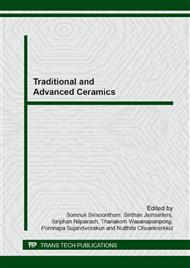[1]
X.Z. Li, F.B. Li, C.M. Fan, Y.P. Sun, Photoelectrocatalytic degradation of humic acid in aqueous solution using a Ti/TiO2 mesh photoelectrode, Water Res. 36 (2002) 2215–2224.
DOI: 10.1016/s0043-1354(01)00440-7
Google Scholar
[2]
C. Musikavong, S. Wattanachira, T. F Marhaba, P. Pavasant, Reduction of organic matterand trihalomethane formation potential in reclaimed water from treated industrial estate wastewater by coagulation, J. Hazard. Mater. B. 127 (2005) 58–67.
DOI: 10.1016/j.jhazmat.2005.06.037
Google Scholar
[3]
H.L. Qin, G.B. Gu, S. Liu, Preparation of nitrogen–doped titania with visible–light activity and its application, Chimie. 11 (2008) 95–100.
DOI: 10.1016/j.crci.2007.06.004
Google Scholar
[4]
W. Zhang, Y. Chen, S. Yu, S. Chen, Y. Yin, Preparation and antibacterial behavior of Fe3+-doped nanostructured TiO2 thin films, Thin Solid Films. 516 (2008) 4690–4694.
DOI: 10.1016/j.tsf.2007.08.053
Google Scholar
[5]
L. Sikong, P. Kongsong, V. Rachpech, Water disinfection using Fe3+ and N–doped 3SnO2/TiO2 thin films coated on glass fibers, Adv. Mater. Res. 148–149 (2011) 1501–1506.
DOI: 10.4028/www.scientific.net/amr.148-149.1501
Google Scholar
[6]
Z. Liuxue, L. Peng, S. Zhixing, Photocatalysis anatase thin film coated PAN fibers prepared at low temperature, Mater. Chem. Phys. 98 (2006) 111–115.
DOI: 10.1016/j.matchemphys.2005.08.071
Google Scholar
[7]
B. Xin, D. Ding, Y. Gao, X. Jin, H. Fu, P. Wang, Preparation of nanocrystalline Sn–TiO2-X via a rapid and simple stannous chemical reducing route, Appl. Surf. Sci. 255 (2009) 5896–5901.
DOI: 10.1016/j.apsusc.2009.01.027
Google Scholar
[8]
X. Cheng, X. Yu , Z. Xing, J. Wan, Enhanced photocatalytic activity of nitrogen doped TiO2 anatase nano–particle under simulated sunlight irradiation, Energy Procedia. 16 (2012) 598–605.
DOI: 10.1016/j.egypro.2012.01.096
Google Scholar
[9]
A. J. Zaleska, W. Sobezak, E. Grabowska, J. Hupka, Preparation and photocatalytic activity of boron modified TiO2 under uv and visible light, Appl. Catal. B. Environ. 78 (2008) 92–100.
DOI: 10.1016/j.apcatb.2007.09.005
Google Scholar
[10]
X. Zhangand, Q. Liu, Preparation and characterization of titania photocatalyst co–doped with boron, nickel, and cerium, Mateiar. Lett. 62 (2008) 2589–2592.
DOI: 10.1016/j.matlet.2007.12.061
Google Scholar
[11]
J. Ying, H. Bai, Q. Jiang, J. Lian, visible–light photocatalysis in nitrogen–carbon–doped TiO2 films obtained by heating TiO2 gel–film in an ionized N2 gas, Thin Solid Films 516 (2008) 1736–1742.
DOI: 10.1016/j.tsf.2007.05.034
Google Scholar


